Vietnamese mayo, a beloved condiment in Vietnamese cuisine, offers a delightful blend of tanginess and creaminess. With its unique flavor profile, it adds a distinct touch to various dishes.
Made with key ingredients like rice vinegar and fish sauce, Vietnamese mayo can be used to elevate banh mi sandwiches, create flavorful spreads and dips, or infuse fusion recipes with a touch of Vietnamese flair.
In this article, we will delve into the world of Vietnamese mayo, exploring traditional recipes, variations, its culinary uses, and even vegan alternatives. Get ready to unlock the secrets of this tantalizing condiment and take your taste buds on a flavorful journey.
What is Vietnamese mayo?
Vietnamese mayo is a condiment widely used in Vietnamese cuisine. It is known for its unique flavor profile, combining creaminess and tanginess in perfect harmony. The key ingredients that give Vietnamese mayo its distinct taste are rice vinegar and fish sauce. Rice vinegar adds a mild acidity, while fish sauce brings a savory umami flavor. This combination creates a balance that complements a variety of dishes.
The versatility of Vietnamese mayo is one of its defining features. It can be used as a spread or dip, enhancing the flavors of sandwiches, wraps, and banh mi. Its creamy texture and tangy notes make it a perfect accompaniment to salads and seafood dishes as well.
What does Vietnamese mayo taste like?
Vietnamese mayo has a distinct and delicious flavor profile. It is characterized by a creamy texture and a delightful balance of tanginess and umami notes. The tanginess comes from the addition of rice vinegar, which lends a subtle acidity to the mayo. Meanwhile, the umami flavor is derived from the inclusion of fish sauce, which provides a savory depth.
The overall taste of Vietnamese mayo is rich, flavorful, and slightly tangy. It adds a unique dimension to dishes, enhancing their taste without overpowering other flavors. Whether used as a spread in banh mi sandwiches, a dressing for salads, or a dip for spring rolls, Vietnamese mayo contributes a creamy and tangy element that elevates the overall dining experience.
Vietnamese mayo recipe
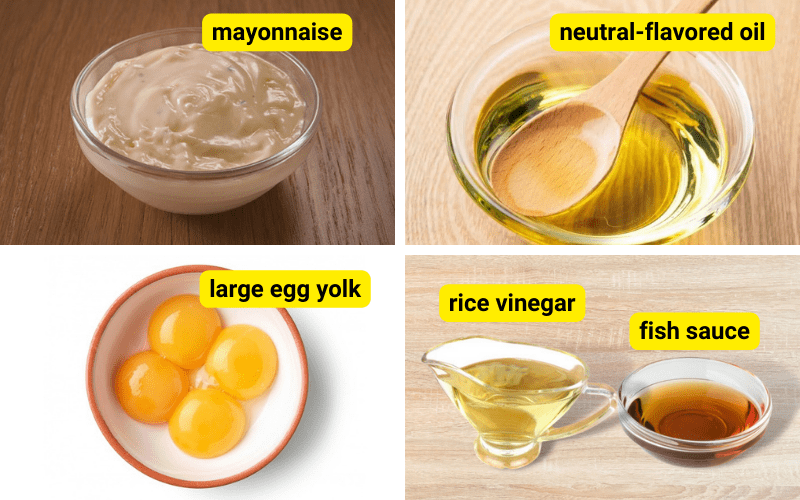
Vietnamese mayo recipe yields a creamy and tangy Vietnamese mayo, perfect for adding a burst of flavor to your dishes.
How To Make Vietnamese Mayo?
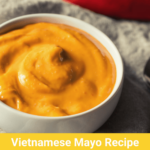
Unlock the exquisite flavors of Vietnamese mayo. Discover tangy and creamy delights, from banh mi sandwiches to innovative fusion creations. Explore recipes and variations now.
- Mixing bowl
- Whisk or electric mixer
- Measuring spoons
- Airtight container for storage
- 1 cup of mayonnaise
- 1 cup of neutral-flavored oil (such as canola or vegetable oil)
- 1 large egg yolk
- 1 tablespoon of rice vinegar
- 1 tablespoon of fish sauce (such as nuoc mam)
- 1 teaspoon of sugar
- 1 clove of garlic, minced (optional)
- ½ teaspoon of lime juice (optional)
Vietnamese mayo ingredients form the basis of a unique condiment. You can adjust the amount according to your taste preferences.
Gradually add the oil to the mixture, starting with a few drops at a time. Whisk continuously as you add the oil. This process is crucial for achieving a creamy and emulsified consistency.
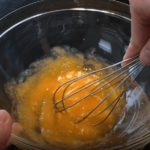
Continue adding the oil in a slow and steady stream while whisking vigorously. This helps to create a stable emulsion.
As you add the oil and whisk, the mixture will thicken and become creamy. Keep whisking until all the oil is incorporated and the mayo reaches your desired consistency.
Taste the mayo and adjust the seasonings if needed. Add more rice vinegar for extra tanginess or sugar for a touch of sweetness. You can also adjust the amount of minced garlic to your preference.
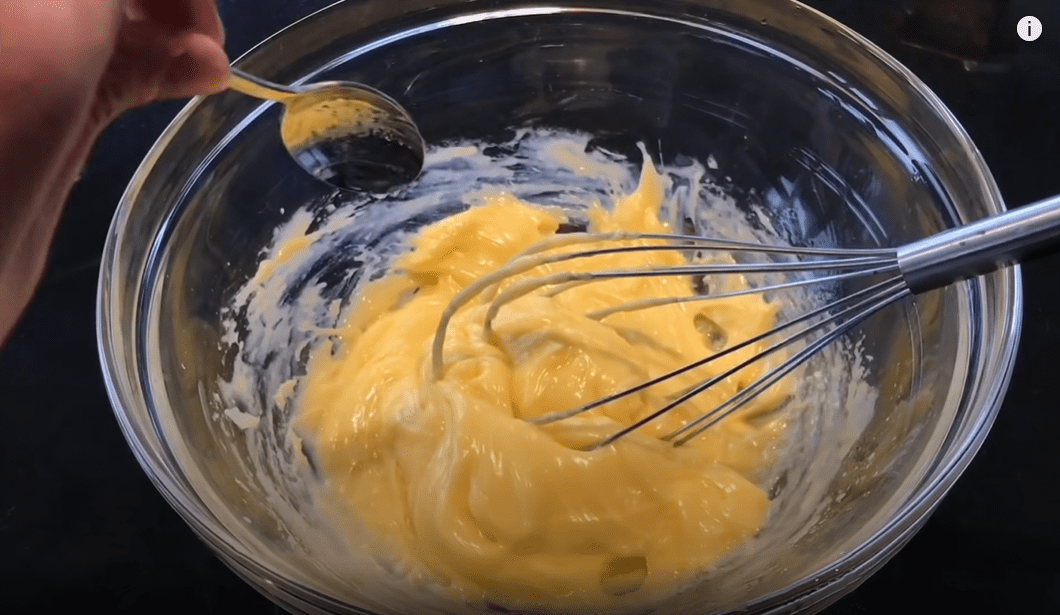
Transfer the Vietnamese mayo to a clean jar or airtight container.
Refrigerate the mayo for at least 30 minutes before using. This allows the flavors to meld together and the mayo to firm up.
Vietnamese mayo ingredients form the basis of a unique condiment. You can adjust the amount according to your taste preferences.
Customize Your Homemade Vietnamese Mayo:
- Experiment with additional flavors and spices like chili flakes, lime zest, or herbs to personalize your mayo.
- Adjust the thickness of the mayo by adding more or less oil. For a thinner consistency, add a bit of water or lemon juice.
Enjoy your homemade Vietnamese mayo as a versatile condiment, adding a tangy and creamy twist to sandwiches, wraps, salads, and more. Store any leftovers in the refrigerator for up to one week.
What are the health benefits of Vietnamese mayo?
Health benefits of Vietnamese mayo
Vietnamese mayo, when consumed in moderation and as part of a balanced diet, can offer certain nutritional benefits. Here are some key highlights and considerations for incorporating Vietnamese mayo into a healthy eating plan:
Nutritional highlights of Vietnamese mayo
| Nutrient | Amount per Serving (1 tbsp) |
| Calories | 100 |
| Total Fat | 11g |
| Saturated Fat | 1.5g |
| Cholesterol | 5mg |
| Sodium | 180mg |
| Carbohydrates | 0g |
| Protein | 0g |
Moderation and balance in consumption
- Vietnamese mayo is a calorie-dense condiment due to its high fat content. It is important to consume it in moderation to maintain a balanced diet.
- The saturated fat and cholesterol content in Vietnamese mayo should be considered for individuals with specific dietary restrictions or health concerns.
- Portion control is key. Be mindful of the amount of Vietnamese mayo used to avoid excessive calorie intake.
Incorporating Vietnamese mayo into a healthy diet
- Vietnamese mayo can be part of a healthy diet when paired with nutrient-rich ingredients such as lean proteins, whole grains, and plenty of vegetables.
- Use it as a flavor enhancer rather than the main component of a dish to limit overall fat and calorie intake.
- Consider homemade versions with quality ingredients and adjust the recipe to control the amount of oil and other additives.
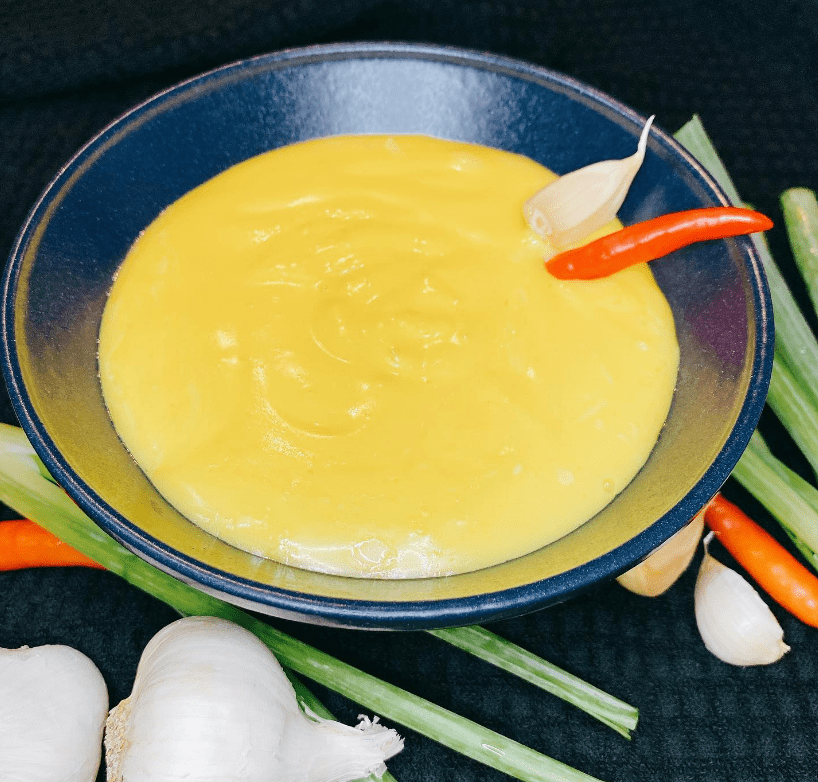
What to serve with Vietnamese mayo?
Vietnamese mayo is a versatile condiment that pairs well with a variety of dishes. Here are some delightful options to serve with Vietnamese mayo:
- Banh Mi Sandwiches: Vietnamese mayo is a classic component of banh mi sandwiches, it calls Vietnamese mayo banh mi. Spread it on the bread for a creamy and tangy addition to flavorful fillings like grilled meats, pickled vegetables, and fresh herbs.
- Spring Rolls: Vietnamese mayo makes a delicious dipping sauce for spring rolls. Its creamy texture and tangy flavor complement the fresh and crisp ingredients wrapped in delicate rice paper.
- Grilled Meats: Use Vietnamese mayo as a marinade or sauce for grilled meats such as chicken, pork, or beef. Its tanginess adds a burst of flavor and helps to keep the meat moist and tender.
- Salads: Drizzle Vietnamese mayo as a dressing over salads, especially those with an Asian twist. Its creamy consistency and tangy notes bring a delightful creaminess to greens, vegetables, or even fruit salads.
- Fries and Snacks: Vietnamese mayo can be served as a dipping sauce for French fries, sweet potato fries, or other snacks like chicken wings or shrimp tempura. Its tanginess and creaminess complement the savory flavors and add a touch of indulgence.
- Wraps and Rolls: Vietnamese mayo can be used as a spread or dressing in wraps and rolls, such as lettuce wraps, summer rolls, or rice paper rolls. It adds a creamy and tangy element to the fillings, enhancing the overall taste.
- Seafood: Serve Vietnamese mayo alongside seafood dishes like grilled shrimp, fish cakes, or crab cakes. Its tanginess pairs well with the delicate flavors of seafood, providing a delicious contrast.
- Burgers and Sliders: Spread Vietnamese mayo on burgers or sliders for a unique twist. Its tangy and creamy nature adds a layer of flavor and richness to the savory patties.
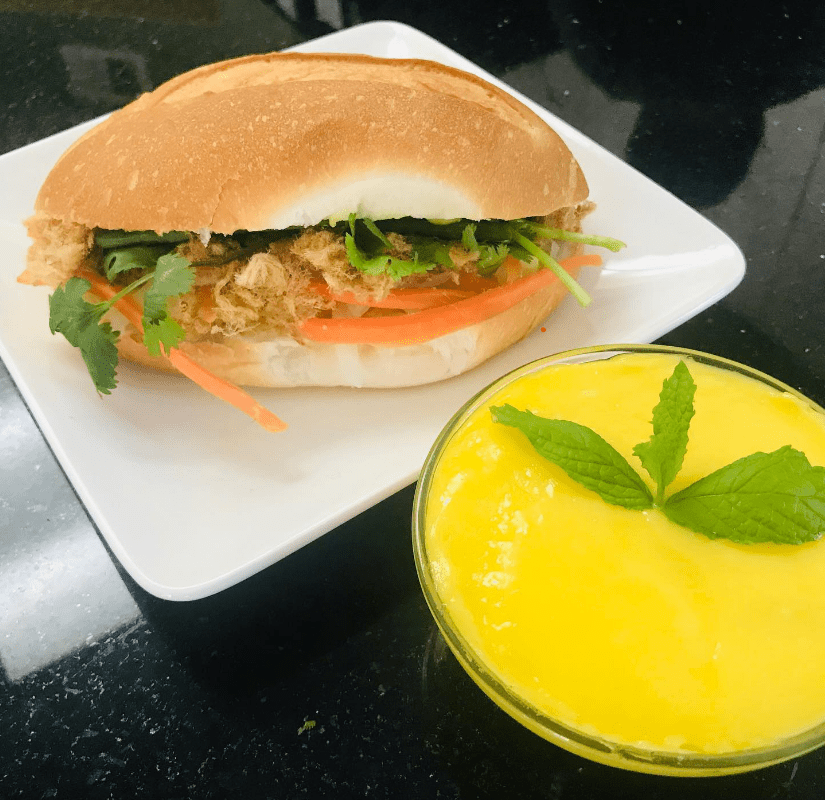
Variations of Vietnamese mayo
Variations of Vietnamese mayo offer exciting flavor twists and opportunities to customize this condiment. Here are a few variations to consider:
- Garlic Vietnamese Mayo: Infuse minced garlic into the mayo for an extra burst of flavor. Add 1-2 cloves of minced garlic to the base recipe and adjust the amount to suit your taste.
- Butter Vietnamese mayo: Vietnamese mayo butter can be used as a spread for sandwiches, bread, or rolls, providing a tangy and creamy element to your meal. It can also be used to enhance the flavor of grilled meats, roasted vegetables, or seafood by adding a delicious buttery and tangy coating.
- Spicy Vietnamese Mayo: Add a kick of heat by incorporating chili flakes or Sriracha sauce. Start with a small amount and adjust the spiciness according to your preference.
- Citrus Vietnamese Mayo: Enhance the tanginess with a hint of citrus zest or juice. Add a teaspoon of lime or lemon zest, or a splash of juice to the base recipe for a refreshing twist.
- Herbed Vietnamese Mayo: Elevate the flavor with fresh herbs like cilantro, basil, or mint. Finely chop the herbs and stir them into the mayo for a vibrant and herbaceous kick.
- Smoky Vietnamese Mayo: Infuse a smoky essence by incorporating a dash of smoked paprika or chipotle powder. This variation adds a unique and complex flavor to the mayo.
- Ginger-Sesame Vietnamese Mayo: Add grated ginger and a drizzle of sesame oil to the base recipe for an Asian-inspired twist. This variation pairs well with dishes featuring Asian flavors.
- Curry Vietnamese Mayo: Stir in a teaspoon of curry powder or curry paste to infuse a fragrant and aromatic twist into the mayo. This variation adds depth and complexity to the flavor profile.
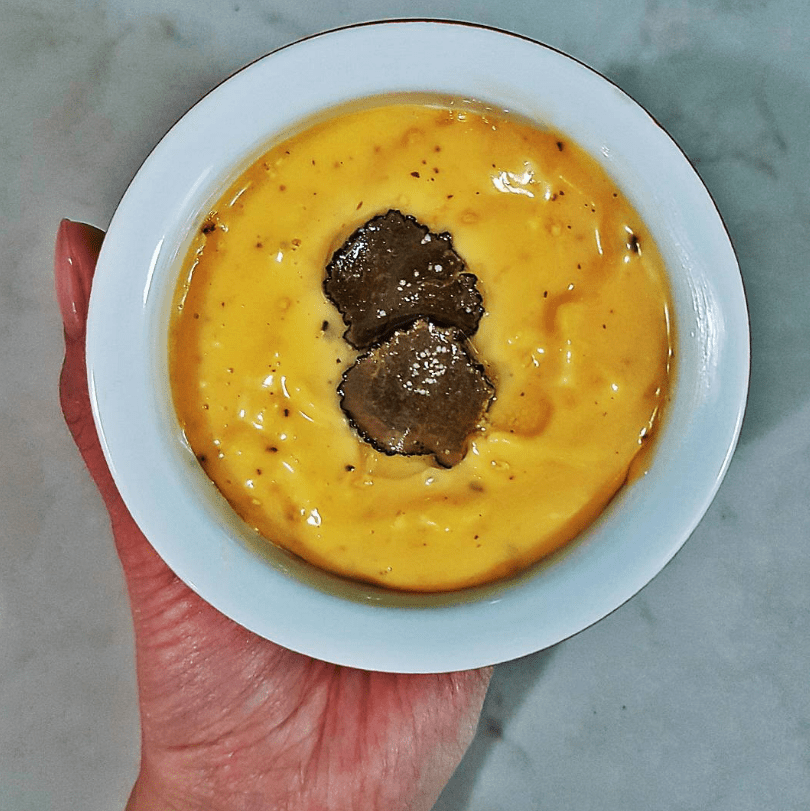
Substitutes for Vietnamese mayo recipes
If you’re looking for substitutes for Vietnamese mayo in recipes, consider these alternatives:
- Regular Mayonnaise: Traditional mayonnaise can be used as a substitute for Vietnamese mayo in most recipes. While it won’t have the exact flavor profile, it will provide a creamy and tangy element to your dishes.
- Sriracha Mayo: Combine regular mayonnaise with Sriracha sauce to create a spicy and flavorful substitute. Adjust the amount of Sriracha according to your desired level of heat.
- Greek Yogurt: For a healthier option, Greek yogurt can be used as a substitute. It offers a creamy texture and a slightly tangy flavor that can work well in certain dishes.
- Sour Cream: Sour cream can be used as a substitute in recipes that require a creamy and tangy element. It may alter the flavor slightly, so consider adjusting other seasonings accordingly.
- Avocado: Mashed or pureed avocado can provide a creamy and nutritious substitute for Vietnamese mayo. It works well in salads, spreads, and dressings, adding a unique flavor and texture.
- Tahini: Tahini, a paste made from ground sesame seeds, can be used as a substitute in certain recipes. It offers a nutty and creamy consistency that complements various dishes.
- Cashew Cream: Soak cashews and blend them with water to create a creamy cashew cream. This plant-based substitute can provide a rich and smooth texture in recipes that call for Vietnamese mayo.
How to store of Vietnamese mayo?
Proper storage of Vietnamese mayo is essential to maintain its freshness and flavor. Follow these guidelines to ensure your homemade or store-bought Vietnamese mayo stays delicious:
Refrigeration
Vietnamese mayo should always be stored in the refrigerator. The cold temperature helps preserve its quality and prevents bacterial growth.
Airtight Container
Transfer your Vietnamese mayo to an airtight container before storing it in the refrigerator. This helps maintain its consistency and prevents absorption of odors from other foods.
Labeling and Date
Label the container with the date of preparation or the expiration date of the store-bought Vietnamese mayo. This will help you keep track of its freshness and ensure timely consumption.
Shelf Life
Homemade Vietnamese mayo typically stays fresh for about 1 to 2 weeks in the refrigerator, while store-bought varieties may have a longer shelf life due to preservatives. Always check the label for specific storage instructions and expiration dates.
Spoilage Signs
Discard Vietnamese mayo if you notice any signs of spoilage, such as mold, off smells, or changes in texture or color. Trust your senses and prioritize food safety.
Cross-Contamination
To avoid cross-contamination, use a clean utensil each time you scoop out Vietnamese mayo from the container. This helps prevent the introduction of bacteria that may lead to spoilage.
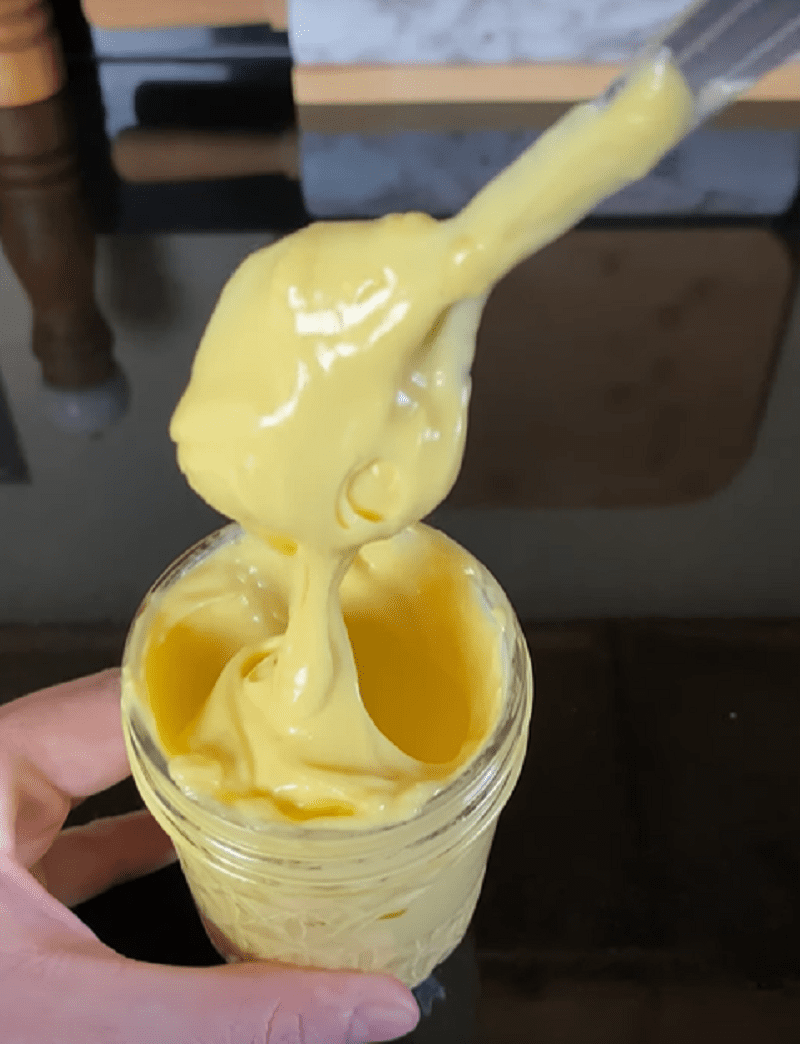
Common mistakes when making Vietnamese mayo
While making Vietnamese mayo is relatively straightforward, there are a few common mistakes to be aware of to ensure the best results. Avoiding these pitfalls will help you achieve a creamy and flavorful Vietnamese mayo every time:
- Adding Oil Too Quickly: One of the most common mistakes is adding the oil too quickly during the emulsification process. Adding it slowly allows the oil to incorporate properly and create a stable emulsion. Rushing this step can result in a broken or separated mayo.
- Using the Wrong Oil: Choosing the right oil is crucial for achieving the desired flavor and texture. Opt for a neutral-flavored oil, such as canola or vegetable oil, as strong-flavored oils can overpower the taste of the mayo.
- Not Whisking Vigorously Enough: Whisking vigorously during the emulsification process is essential to ensure the ingredients are well combined and a smooth consistency is achieved. Insufficient whisking can lead to a runny or lumpy mayo.
- Skipping the Seasonings: Vietnamese mayo derives its unique flavor from rice vinegar, fish sauce, and other seasonings. Skipping or underestimating the importance of these ingredients can result in a bland mayo lacking the characteristic tanginess.
- Not Adjusting Consistency: Achieving the right consistency is key. Adding too much oil can result in an overly thick mayo, while adding too little can yield a runny texture. Adjust the oil quantity as needed to achieve the desired thickness.
- Not Tasting and Adjusting: The taste of Vietnamese mayo can vary depending on personal preferences and ingredient qualities. Taste the mayo during preparation and adjust the seasonings as necessary to achieve the desired flavor profile
Tips and tricks for a Vietnamese mayo
Tips and Tricks for Vietnamese Mayo: Troubleshooting Texture and Consistency
Creating a smooth and creamy Vietnamese mayo can sometimes present challenges. Here are some tips and tricks to troubleshoot common texture and consistency issues:
Separation
- If your Vietnamese mayo has separated, meaning the oil has separated from the other ingredients, try whisking it vigorously or using an immersion blender to re-emulsify the mixture.
- Another method is to start with a fresh egg yolk and slowly drizzle the separated mayo into it while whisking continuously to achieve a stable emulsion.
Thinning
- If your Vietnamese mayo is too thin or runny, it might mean that you added too much oil or didn’t whisk it enough.
- To fix this, you can whisk in additional mayonnaise gradually to thicken the mixture.
- Alternatively, create a separate batch of mayo and gradually whisk in the thin mayo to thicken it gradually.
Thickening
- If your Vietnamese mayo is too thick or stiff, it might mean that you added too much oil or didn’t incorporate enough liquid.
- To fix this, you can add small amounts of water or lemon juice while whisking until the desired consistency is reached.
- Another option is to create a separate batch of mayo without adding any oil and then gradually whisk the thick mayo into it to achieve a smoother texture.
Adjusting consistency
- Achieving the perfect consistency is a matter of personal preference. If you prefer a thinner mayo, add a little water or lemon juice while whisking.
- For a thicker mayo, increase the amount of oil gradually while whisking until the desired thickness is achieved.
- Remember to make adjustments in small increments to prevent over-thinning or over-thickening the mayo.
Temperature matters
- The temperature of the ingredients can affect the texture of your Vietnamese mayo. Make sure the eggs and other ingredients are at room temperature before starting.
- Additionally, if the environment is too hot or humid, it can make the emulsification process more challenging. Consider working in a cool and dry environment for better results.
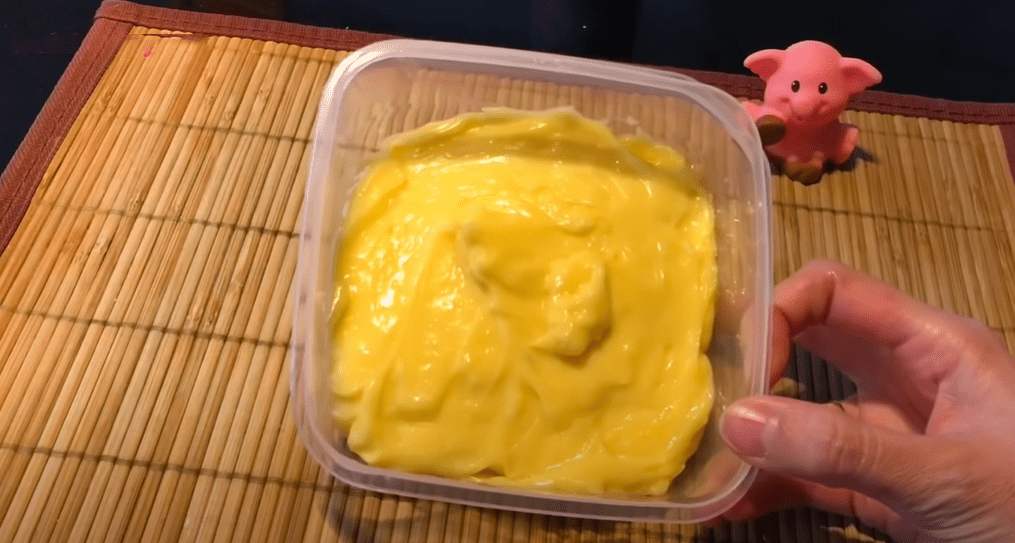
FAQs
What makes Vietnamese mayo different from regular mayo?
Here is a table highlighting the key differences between Vietnamese mayo and regular mayo:
| Aspect | Vietnamese Mayo | Regular Mayo |
| Flavor Profile | Creamy, tangy, with umami notes | Creamy, milder taste |
| Key Ingredients | Rice vinegar, fish sauce | Vinegar, mustard, or lemon |
| Culinary Application | Vietnamese cuisine | Broad range of recipes |
| Cultural Association | Vietnamese | Global |
| Traditional Use | Banh mi sandwiches, dips, dressings | Sandwiches, salads, dips |
| Customization | Variations with additional flavors possible | Variations with different seasonings possible |
| Vegan Options | Can be made vegan with plant-based substitutes | Vegan versions available |
| Gluten-Free Options | Can be made gluten-free with proper ingredients | Gluten-free versions available |
| Freezing | Not recommended to freeze | Not recommended to freeze |
These factors distinguish Vietnamese mayo from regular mayo, showcasing its unique flavor profile, specific ingredients, and cultural associations. While regular mayo is versatile and widely used, Vietnamese mayo brings a distinct taste and is traditionally associated with Vietnamese cuisine.
Can I make Vietnamese mayo without fish sauce?
Yes, you can make Vietnamese mayo without fish sauce if you prefer to avoid it or don’t have it on hand. While fish sauce is a traditional ingredient in Vietnamese mayo and contributes to its distinctive flavor, you can still create a tasty variation without it.
To substitute fish sauce in Vietnamese mayo, consider using soy sauce or tamari sauce as a replacement. These alternatives provide a savory umami flavor that can mimic the depth of taste that fish sauce adds.
Alternatively, you can omit the fish sauce altogether and focus on the other components of the mayo, such as rice vinegar, garlic, and lime juice, to create a tangy and creamy base.
Experiment with different variations and adjustments to suit your taste preferences and dietary restrictions. While the absence of fish sauce may alter the flavor profile slightly, it still allows you to enjoy the creamy and tangy goodness of Vietnamese mayo.
Can I use Vietnamese mayo in vegan recipes?
The traditional Vietnamese mayo recipe contains eggs, which makes it non-vegan. However, you can adapt Vietnamese mayo to suit a vegan diet by using plant-based alternatives for eggs and mayonnaise.
To make vegan Vietnamese mayo, replace the egg yolk with ingredients like silken tofu, aquafaba (the liquid from canned chickpeas), or vegan mayonnaise as a base. You can then follow the rest of the Vietnamese mayo recipe, incorporating rice vinegar, seasonings, and optional flavors, to achieve a vegan-friendly version.
Experiment with different substitutions and ratios to find the combination that best suits your taste and dietary preferences. Vegan Vietnamese mayo can still provide a creamy and tangy element to enhance your vegan dishes.
Can I use Vietnamese mayo as a dipping sauce?
Absolutely! Vietnamese mayo can be used as a versatile dipping sauce. Its creamy texture and tangy flavor make it an excellent accompaniment for a variety of foods. It pairs well with spring rolls, dumplings, crispy tofu, grilled meats, seafood, and even French fries.
For dipping purposes, you can serve Vietnamese mayo as is, or you can customize it by adding extra seasonings such as chili flakes, lime juice, or minced garlic. These additions can further enhance the flavor and tailor the dipping sauce to your preferences.
Whether you’re enjoying it with appetizers, finger foods, or as a condiment for your main course, Vietnamese mayo as a dipping sauce provides a tangy and creamy element that adds depth and richness to your culinary experience.
Is Vietnamese mayo gluten-free?
In its traditional form, Vietnamese mayo is typically gluten-free. The base ingredients of eggs, oil, rice vinegar, and fish sauce do not contain gluten. However, it’s important to be cautious with store-bought Vietnamese mayo or variations that may include additional ingredients or additives. Always check the label to ensure that the product is specifically labeled as gluten-free.
If you are making Vietnamese mayo at home, using gluten-free ingredients guarantees its gluten-free status. Check that the rice vinegar and fish sauce you use are certified gluten-free, as some brands may add gluten-containing ingredients as thickeners or flavorings.
As always, if you have gluten intolerance or celiac disease, it’s crucial to read labels, verify ingredients, and choose gluten-free options to ensure your dietary needs are met.
Can I freeze Vietnamese mayo?
Freezing Vietnamese mayo is not recommended. Mayo tends to separate and change in texture when frozen and thawed. The emulsion can break, leading to an undesirable consistency and separation of ingredients.
To maintain the quality and freshness of Vietnamese mayo, it is best stored in the refrigerator at a consistently cool temperature. Keep it in an airtight container to prevent absorption of odors from other foods and maintain its flavor and texture.
If you find that you have excess Vietnamese mayo that you won’t consume before it spoils, it’s advisable to scale down the recipe or make smaller batches to avoid waste. Enjoy the deliciousness of Vietnamese mayo while it’s fresh, and store any leftovers in the refrigerator for optimal quality.
What gives Vietnamese mayo its distinct flavor?
Vietnamese mayo derives its distinct flavor from the combination of key ingredients. The two primary components responsible for its unique taste are rice vinegar and fish sauce.
Rice vinegar contributes a mild acidity and subtle tanginess to the mayo. It adds a delicate and slightly sweet flavor that complements the other ingredients.
Fish sauce, such as nuoc mam, provides a savory umami depth to Vietnamese mayo. It adds complexity and a unique taste characteristic of Vietnamese cuisine.
The balance between the tanginess of rice vinegar and the umami flavor of fish sauce creates the distinctive taste that sets Vietnamese mayo apart from regular mayo.
Can I adjust the tanginess or creaminess of Vietnamese mayo?
Yes, you can adjust the tanginess and creaminess of Vietnamese mayo according to your personal preferences. The beauty of homemade mayo is that you have control over the ingredients and can tailor it to suit your taste.
To increase the tanginess, you can add a bit more rice vinegar gradually, tasting as you go until you achieve the desired level of tanginess.
For a creamier mayo, you can experiment with adjusting the oil-to-egg yolk ratio. Adding a little more oil can result in a thicker and creamier consistency.
How can I fix separation or texture issues in Vietnamese mayo?
If you encounter separation or texture issues with your Vietnamese mayo, there are a few steps you can take to fix them:
- Re-emulsify: If your Vietnamese mayo has separated, meaning the oil has separated from the other ingredients, start by whisking it vigorously or using an immersion blender to re-emulsify the mixture. This can help bring the ingredients back together and create a smoother consistency.
- Gradual Addition: If your mayo is too thin or runny, it might mean that you added the oil too quickly. To fix this, start with a fresh egg yolk in a separate bowl and slowly drizzle the separated mayo into it while whisking continuously. This gradual addition allows the oil to incorporate properly and creates a stable emulsion.
- Thickening: If your Vietnamese mayo is too thin, you can whisk in additional mayo gradually to thicken the mixture. Start with a small amount and continue adding until you reach the desired consistency. This helps to thicken the mayo without compromising the flavor or texture.
- Thin Out: Conversely, if your mayo is too thick, you can add small amounts of water or lemon juice while whisking until the desired consistency is achieved. The added liquid helps to thin out the mayo and create a smoother texture.
- Adjustments: Throughout the process, remember to taste the mayo and adjust the seasonings if necessary. You can add more rice vinegar for extra tanginess or sugar for a touch of sweetness. This ensures that your mayo has the desired flavor profile, even as you work on the texture.
Conclusion
Ultimately, Vietnamese mayo, with its unique flavor profile and creamy tanginess, is a condiment that adds a delightful twist to various dishes. From banh mi sandwiches to salads and beyond, it offers a burst of flavor that elevates the culinary experience.
In this article, we explored the basics of Vietnamese mayo, including its key ingredients like rice vinegar and fish sauce, and how they contribute to the perfect balance of creaminess and tanginess. We learned how to make authentic Vietnamese mayo at home, and even explored variations and substitutes for customization.
With Vietnamese mayo in your culinary arsenal, you can unlock a world of possibilities. From traditional Vietnamese dishes to fusion creations, this condiment provides versatility and adds depth to your recipes. Whether you choose to enjoy it as a spread, dip, or dressing, Vietnamese mayo has the power to enhance your dishes and impress your taste buds.
Remember to source quality ingredients, adjust seasonings to your taste, and use moderation in consumption. Vietnamese mayo can be a delicious addition to a well-rounded and balanced diet.
So, go ahead and explore the wonders of Vietnamese mayo in your kitchen. Let its tangy and creamy allure captivate your taste buds and bring a touch of Vietnamese flavor to your culinary creations. Enjoy the journey of discovering new taste sensations and the endless possibilities that Vietnamese mayo has to offer.